Christmas? Check. Hanukkah? History. But I’m still celebrating. It’s Kwanzaa! Any holiday that honors the foods we grow has me on board, so naturally, I love Kwanzaa, which means first fruits of the harvest in Swahili. Celebrate with this bowl of Africa’s mazao — crops. l originally created it for Juneteenth, but I’m calling it a Kwanzaa Bowl, and it’s perfect for the holiday, featuring seasonal, sturdy produce and pantry-friendly staples.
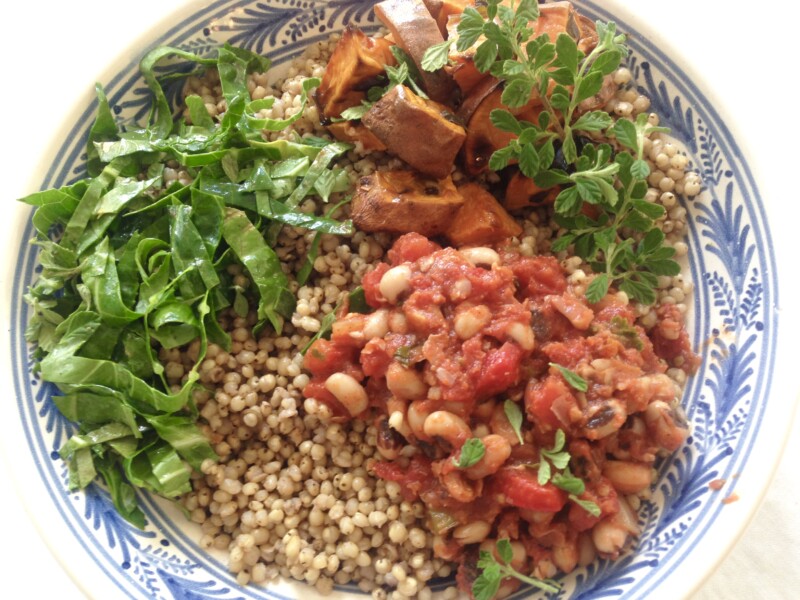
- sorghum — This gluten-free ancient grain goes back millennia and was introduced to America over three centuries ago. It’s been a southern staple crop ever since.
- sweet potatoes — In America, we confuse yams and sweet potatoes. What came from Africa are yams, true tubers, with rough skins and pale, starchy flesh. Sweet potatoes, root vegetables, are smoother skinned, with soft. orange flesh. Both are sweet, yet low glycemic and high in antioxidants but sweet potatoes grow more plentifully here.
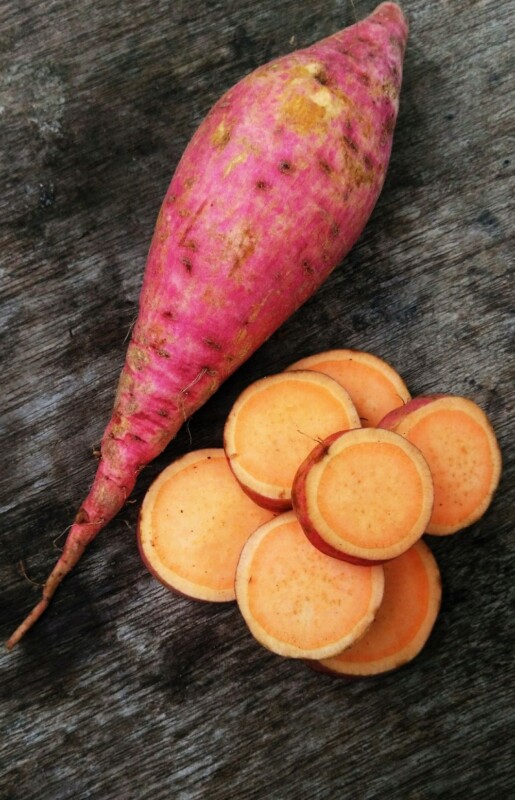
- black-eyed peas — Born to thrive when it’s hot, these beans can also survive the freezer. Cooking up a big pot of these black eyed beauties means enjoying bright summer flavors now and long after your summer tan has faded. Freeze the leftovers then pull your ready-made meal out some miserable night in October when the idea of cooking reduces you to tears.
- peanuts — Not a true nut, but a legume, a member of the bean and pea family. It’s rich in protein, fiber, and overall deliciousness, and as with other legumes, peanuts enrich the soil they’re grown in.
- collards — According to James Beard Award-winning food historian and Koshersoul author Michael Twitty, collards aren’t native to Africa, but they became the mainstay of slaves in the south, who supplemented their diet by growing collards and other hearty, heat-tolerant greens. As he writes,
Jump to the recipe or stick around for Kwanzaa bowl backstory.“This food connects us to the globe. It connects us to Africa. It connects us to slavery, to freedom, to sharecropping, to migration, to triumph, to survival. It’s a powerful symbol of our history, our social identity, and the cultural politics we negotiate our lives by.”
How to Make a Kwanzaa Bowl
- Bring water or vegetable broth to boil in a large pot. Add sorghum. Keep the pot on high heat and continue boiling for another 5 minutes. Then reduce the heat to low, cover the pod and let everything simmer. It will need little attention, just peek in occasionally and give it a stir so the sorghum doesn’t get lonely and there’s still plenty of liquid in the pot.
- After an hour, grains should be tender and plump. Pour off any liquid the grains haven’t absorbed. Toss sorghum with coconut oil, cumin and lemon juice. Season generously with sea salt and freshly ground pepper.
- Meanwhile, spread chopped sweet potato onto a rimmed baking sheet. Drizzle with 1 tablespoon of the olive oil and sprinkle with a little sea salt.
- Roast sweet potato in the oven for 30 minutes, stirring occasionally to prevent charring. When sweet potato is tender and darkened at the edges, remove from oven and set aside.
- In a good-sized soup pot, heat the remaining tablespoon of olive oil over medium-high heat. When it starts to shimmer, add the chopped onion. Stir and cook for a few minutes, until onion starts to turn translucent. Then add minced garlic and jalapeno, chopped red pepper and celery. Stir and cook for 8 to 10 minutes, or until vegetables soften and become fragrant.
- Stir in the cooked black-eyed peas, the chopped tomatoes, paprika and turmeric. Cover and simmer for 20 to 30 minutes.
- Remove the lid and add the sorghum syrup or molasses to balance flavors. Add fresh thyme leaves and season to taste with sea salt and pepper.
- Wash the collards well. Blot dry. Slice out the thick central stems and discard (or reserve them to make broth later). Stack the collard leaves and roll them up widthwise, forming a tight collard cigar. Using your sharpest knife, slice across as thinly as possible, forming skinny ribbons — collard tinsel — or to use the proper culinary term, chiffonade. Alternately, using the shredding disc, shred the collards in a food processor. You’ll have roughly 2 cups of greens.
- Scoop the collards into a large bowl. Add the minced garlic, lemon juice and olive oil. Toss to combine. Season with sea salt and pepper.
- To serve, scatter a spoon or two of collards into bowls. Spoon sorghum to cover. Top with chopped sweet potato, a few more shreds of collards and a good ladle or two of black-eyed peas. Sprinkle with chopped peanuts and enjoy.
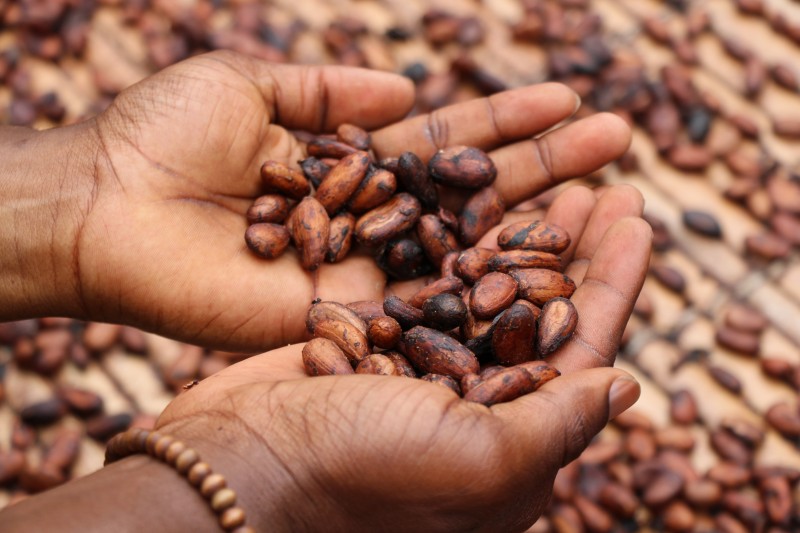
Recipe Tips and Ingredient Swaps
- All Kwanzaa Bowl components can be made a day or two ahead, then kept covered and refrigerated. Assemble when you’re ready. It’s nutrient-dense, rainbow-bright and flavor-packed.
- I make the grain base of this dish with sorghum. Its grains are round and chewy. Sorghum dates back millennia and originated, where else? in Africa. Here’s the thing — sorghum is a slow-cooking grain. Really slow. It needs an hour’s worth of simmering or the aid of an Instant Pot for quicker, most tender results. For a quicker fix, use rice or another whole grain with a rich African history like teff or fonio.
- Peanut allergy? My heart goes out to you. Substitute toasted sunflower seeds or pumpkin seeds. Or both!
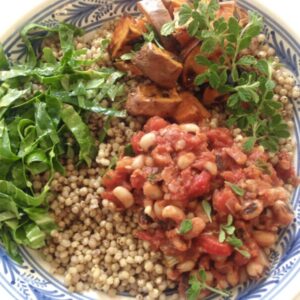
Kwanzaa Bowl
Ingredients
For the sorghum:
- 4 cups water or vegetable broth
- 1 cup sorghum
- 1 tablespoon coconut oil
- 1 teaspoon cumin
- juice of 1 lemon
- sea salt and freshly ground pepper to taste
For the sweet potato:
- 1 sweet potato chopped
- 1 tablespoons olive oil
- a sprinkle of sea salt
For the collards:
- 1 bunch collard greens
- 1 garlic clove minced
- 1 tablespoon olive oil
- 2 tablespoons freshly squeezed lemon juice from 1 juicy lemon
- sea salt and freshly ground pepper to taste
For black-eyed pea stew:
- 1 tablespoon olive oil
- 1 onion chopped
- 2 garlic cloves minced
- 1/2 jalapeno minced
- 1 red pepper chopped
- 1 stalk celery chopped
- 2 cups black-eyed peas cooked and cooled
- 1 28- ounce can chopped fire-roasted tomatoes or about 2 pounds fresh ripe tomatoes 2-3 good-sized tomatoes chopped
- 2 teaspoons paprika
- 1/2 teaspoon turmeric
- 1 sprig fresh thyme leaves
- 1/2 teaspoon sorghum syrup or molasses
- sea salt and freshly ground pepper to taste
To serve:
- 1/2 cup roasted peanuts chopped
Instructions
- Preheat oven to 425 degrees.
- Bring water or vegetable broth to boil in a large pot. Add sorghum. Keep the pot on high heat and continue boiling for another 5 minutes. Then reduce the heat to low, cover the pod and let everything simmer for 1 hour. It will need little attention, just peek in occasionally and give it a stir so the sorghum doesn’t get lonely and there’s still plenty of liquid in the pot.
- After an hour, grains should be tender and plump. Pour off any liquid the grains haven’t absorbed. Toss sorghum with coconut oil, cumin and lemon juice. Season generously with sea salt and freshly ground pepper.
- Meanwhile, spread chopped sweet potato onto a rimmed baking sheet. Drizzle with 1 tablespoon of the olive oil and sprinkle with a little sea salt.
- Roast sweet potato in the oven for 30 minutes, stirring occasionally to prevent charring. When sweet potato is tender and darkened at the edges, remove from oven and set aside.
- In a good-sized soup pot, heat the remaining tablespoon of olive oil over medium-high heat. When it starts to shimmer, add the chopped onion. Stir and cook for a few minutes, until onion starts to turn translucent. Then add minced garlic and jalapeno, chopped red pepper and celery. Stir and cook for 8 to 10 minutes, or until vegetables soften and become fragrant.
- Stir in the cooked black-eyed peas, the chopped tomatoes, paprika and turmeric. Cover and simmer for 20 to 30 minutes.
- Remove the lid and add the sorghum syrup or molasses to balance flavors. Add fresh thyme leaves and season to taste with sea salt and pepper.
- Wash the collards well. Blot dry. Slice out the thick central stems and discard (or reserve them to make broth later). Stack the collard leaves and roll them up widthwise, forming a tight collard cigar. Using your sharpest knife, slice across as thinly as possible, forming skinny ribbons — collard tinsel — or to use the proper culinary term, chiffonade. Alternately, using the shredding disc, shred the collards in a food processor. You’ll have roughly 2 cups of greens.
- Scoop the collards into a large bowl. Add the minced garlic, lemon juice and olive oil. Toss to combine. Season with sea salt and pepper.
- To serve, scatter a spoon or two of collards into bowls. Spoon sorghum to cover. Top with chopped sweet potato, a few more shreds of collards and a good ladle or two of black-eyed peas. Sprinkle with chopped peanuts and enjoy.
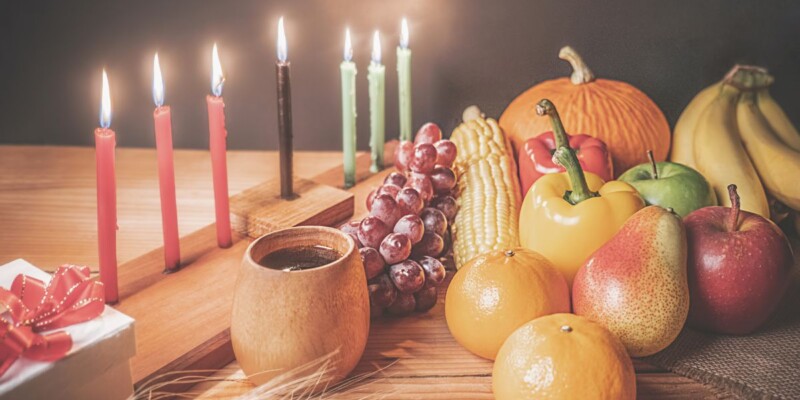
About Kwanzaa
Kwanzaa starts tonight and lasts through January 1 (a good day to eat hopping john). Kwanzaa’s still a new holiday in the grand scheme of things but what it honors is timeless — Africa’s rich influence in America, an influence so vast, it touches all of us, whether your forefathers came on the Mayflower or you’re the first in your family to call this country home.
The Kwanzaa table is bountiful with matunda ya kwanza, the first fruits of the harvest, from the traditional foods and mazao— crops — of Africa to the fusion dishes of the African diaspora, the Caribbean, Latin America and here. Rather than a holiday eat-a-thon, Kwanzaa invites thoughtful feasting, relishing and honoring foods from the earth.
America owes Africa for introducing or cultivating crops including black-eyed peas, peanuts, rice, and that sturdy winter grower, sweet potatoes. All three are easy to grow, nourishing both the soil and us. They’re sky-high in antioxidants and fiber, and in the case of black-eyed peas and peanuts, pack a protein wallop. We’re talking foods that are nutrient-dense and made to last — naturally. They’re available, affordable, nourishing, shelf-stable (dried or canned beans and peanuts) and seasonal (sturdy greens and sweet potatoes, in season now through spring).
Kwanzaa also offers food for thought, paying tribute to seven core precepts of African culture, starting with umoja, which means community, collectiveness, a real keeper of a concept. Coming after winter’s gift-giving frenzy, Kwanzaa is a centering celebration of culture, an honoring of the past, handing down the principles and customs that nourish society, and foods that nourish us. Happy Kwanzaa!
More Kwanzaa Recipes
- Sweet potatoes, peanuts and black-eyed peas come together again in my recipe for African American sweet potato and peanut stew, from my book, Feeding the Hungry Ghost: Life, Faith and What to Eat for Dinner.
- Sukuma wiki means stretch the week. It’s also the name of this fabulous bowl of greens.
- Salvation BEP and Okra stew
- Mafé, a luscious Senegalese stew of sweet potatoes, peanuts and okra from La Cocina’s Nafy Flatley.
- Sally Ann Robinson tomato, corn, green lima and okra soup
- And always, always, always hopping john for New Year’s Day
Discover more delicious African cuisine and culture with the wonderful Netflix series High on the Hog.
And these new books:
- Tanya Holland’s Tanya Holland’s California Soul
- Kwame Omwauchi’s My America
- Michael Twitty’s Koshersoul
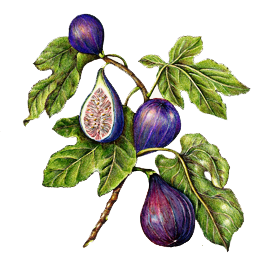

Leave a Reply